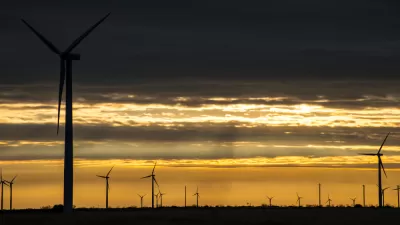Just over a year ago President Obama's draft Clean Power Plan was unveiled. That proposal has been finalized and the president promoted it at a press event on Monday. The final rule is both stronger and more lenient that the original proposal.
"The final rules propose a 32% cut in carbon emissions from power plants by 2030 on 2005 levels, up from the initial proposal of 30%," writes Adam Vaughan, editor of the Guardian's environment site. "However states will only have to comply by 2022 rather than 2020 as originally proposed, and will be able submit their plans on meeting the targets by 2018 instead of 2017."
This rule is aimed at existing power plants and is expected to have the greatest effect on coal-powered plants, though all fossil fuel plants will feel the pinch. Marty Durbin, chief executive of America's Natural Gas Alliance, a trade group representing natural-gas-producing companies, told The Wall Street Journal: "We’re disappointed and discouraged that they [the administration] seem to be ignoring the fact that natural gas has greatly reduced emissions."
Analysts at Sanford C. Bernstein & Co. said the rule would increase utility consumption of natural gas by 7.1 billion cubic feet a day, or 32%, enough to lift national demand for it by about 10%. The big loser—the coal industry—will see consumption drop 23% by 2020, adding to the crisis already rocking mining. Some opponents have labeled the rule a “war on coal.” [Wall Street Journal]
The real winner will be renewables which will get "a head start to wind and solar deployment," according to a White House fact sheet, by driving "more aggressive investment in clean energy technologies than the proposed rule, resulting in 30% more renewable energy generation in 2030 and continuing to lower the costs of renewable energy."
Cap-and-Trade
"A federal model, also expected to be released Monday, would be imposed on the power sectors in states that do not come up with their own plans," writes Alan Neuhauser for US News & World Report. States would be directed toward the two existing programs, the northeast Regional Greenhouse Gas Initiative (RGGI) and the California program.
The model would allow participation in regional cap-and-trade emissions programs, which reward clean-burning power sources by giving them credits they can then sell to heavy polluters.
While push-back that will undoubtedly result much litigation is already coming from coal interests, Vaughan writes that "hundreds of businesses including eBay, Nestle and General Mills have issued their support for Barack Obama’s clean power plan."
FULL STORY: Obama's clean power plan hailed as US's strongest ever climate action

Planetizen Federal Action Tracker
A weekly monitor of how Trump’s orders and actions are impacting planners and planning in America.

Congressman Proposes Bill to Rename DC Metro “Trump Train”
The Make Autorail Great Again Act would withhold federal funding to the system until the Washington Metropolitan Area Transit Authority (WMATA), rebrands as the Washington Metropolitan Authority for Greater Access (WMAGA).

The Simple Legislative Tool Transforming Vacant Downtowns
In California, Michigan and Georgia, an easy win is bringing dollars — and delight — back to city centers.

The States Losing Rural Delivery Rooms at an Alarming Pace
In some states, as few as 9% of rural hospitals still deliver babies. As a result, rising pre-term births, no adequate pre-term care and "harrowing" close calls are a growing reality.

The Small South Asian Republic Going all in on EVs
Thanks to one simple policy change less than five years ago, 65% of new cars in this Himalayan country are now electric.

DC Backpedals on Bike Lane Protection, Swaps Barriers for Paint
Citing aesthetic concerns, the city is removing the concrete barriers and flexposts that once separated Arizona Avenue cyclists from motor vehicles.
Urban Design for Planners 1: Software Tools
This six-course series explores essential urban design concepts using open source software and equips planners with the tools they need to participate fully in the urban design process.
Planning for Universal Design
Learn the tools for implementing Universal Design in planning regulations.
Smith Gee Studio
City of Charlotte
City of Camden Redevelopment Agency
City of Astoria
Transportation Research & Education Center (TREC) at Portland State University
US High Speed Rail Association
City of Camden Redevelopment Agency
Municipality of Princeton (NJ)



























